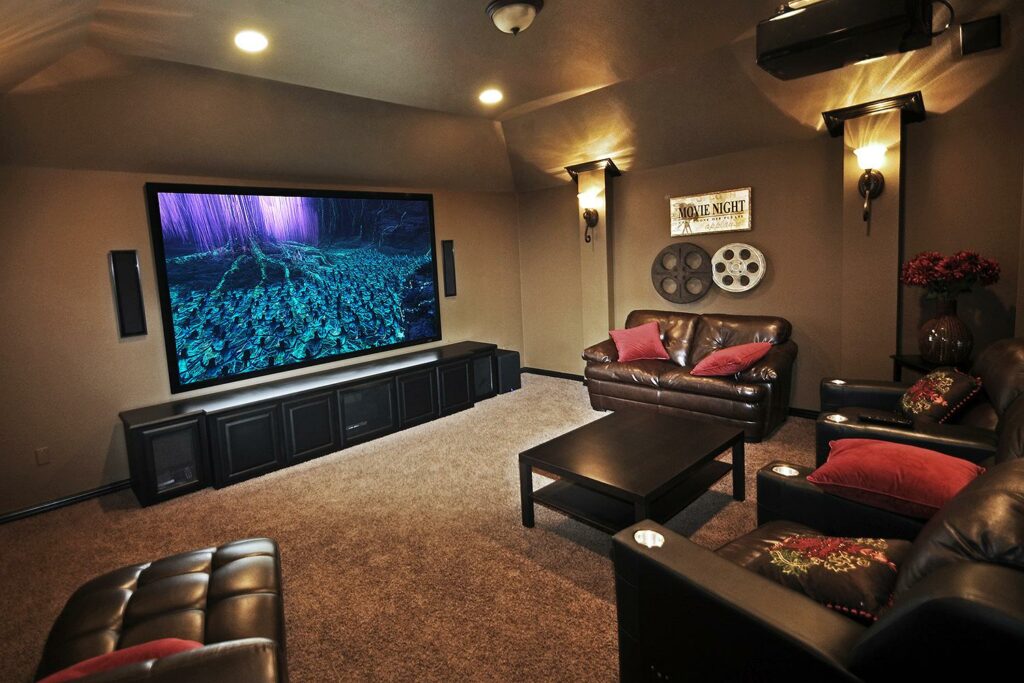Buying and setting up a home theater can be difficult, you need to understand the essentials. Choosing the right screen, receiver and Blu-ray player are the first important step.

Nothing can compare with watching the latest blockbuster movie in your own home theater. The picture and sound are first rate, almost identical to the experience you’d have in a commercial movie theater. Even better, a basketball player won’t sit down in front of you, the restroom is only a few steps away, and the popcorn is free.
The greatest number of inquiries we get at DTV Installations involve home theater. Clients want a state-of-the-art theater, but are afraid they’ll buy the wrong equipment or install it the wrong way.
Of course we’re happy to do all the work, since we serve homeowners and businesses from Manhattan, to Long Island, to New Jersey. But there’s no reason anyone should be scared to try it on their own; it’s not hard as long as you know the essentials. In part one of this guide, we’ll be looking at the electronics you’ll need. In part two, we’ll consider speakers, cables and accessories.
Electronics: The TV Screen
The centerpiece of a home theater is the video display. If you have enough space (think 16’ x 9’ for a small theater, 18’ x 12’ for a medium-sized one, 22’ x 15’ for a big one) and a dark room (if not think about getting shading system), you can install a video projector and screen for a huge picture and cinematic experience. The majority of our clients, though, choose a modern high-definition television. The latest 4K HDTVs can provide extraordinary video quality, and some can even deliver 3D pictures. A standard 1080p HD television will still give you a terrific high-def picture, and at a much lower price.
The biggest decision you’ll have to make is the size of the screen. There’s a full guide on the subject elsewhere on this site, but this should help get you started: most people sit about nine feet away from their display and the ideal screen size for that distance is 72 inches, if it doesn’t overpower your room. Wall-mounted monitors are the most popular and best-looking choice.
Electronics: The Receiver
When you’re installing a home theater, sound from a tiny TV speaker certainly won’t do. You’re going to want a surround sound experience, which means you’ll need a receiver to take the sound from your video devices, process and amplify the audio, and then send it to speakers positioned properly around the theater. Most receivers will also import some combination of over-the-air, internet, and satellite radio signals. The best receiver choices will act as a “traffic cop” for all of your video sources, so that everything is controlled by one box.
At a minimum, you should look for receivers which support Dolby 5.1 surround sound; 7.1 or 9.2 surround sound are a better option for large theaters, and receivers which support high-resolution audio formats like DTS Master Audio and Dolby TrueHD will truly enhance your overall experience. High-current receivers should be considered if you have a large room or regularly listen to loud, powerful music.
Electronics: Blu-ray and Other Options
You probably don’t want a home theater just to watch TV, so don’t invest in a theater and then skimp on external video sources. You may not realize it, but your old DVD player isn’t even capable of delivering a HD signal; you’re going to need a modern Blu-ray player in order to watch movies. (But don’t throw out your old DVDs, they’ll look better when upconverted by a Blu-ray player than they ever have before.)
Just about any Blu-ray player will provide top-notch high-definition video. The most important option to look for is internet connectivity (most have it) which will let you import video and/or audio from sources like Netflix, Amazon, Vudu, YouTube, Pandora and others. Many Blu-ray players also let you access social networking sites (some TVs do that as well) for surfing or multi-screen viewing experiences, and some also have 3D capabilities.
Finally, if you’re into gaming, you’ll want to make sure you have a PS3 or other modern video gaming system. It can either replace or supplement a Blu-Ray player – and the gaming experience in a home theater has to be experienced to be believed.
In the next part of this DTV Installations home theater guide, we’ll talk about setting up your speakers and connecting all of this up together.









